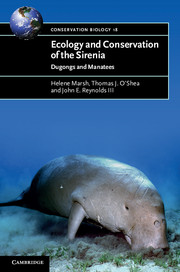Book contents
- Frontmatter
- Contents
- Foreword
- Preface
- Acknowledgements
- 1 Introduction
- 2 Steller’s sea cow
- 3 Affinities, origins and diversity of the Sirenia through time
- 4 Feeding biology
- 5 Behaviour and habitat use
- 6 Life history, reproductive biology and population dynamics
- 7 Threats
- 8 Conservation status
- 9 Conservation opportunities
- References
- List of online supplementary material
- Index
- Plate section
3 - Affinities, origins and diversity of the Sirenia through time
Published online by Cambridge University Press: 05 January 2012
- Frontmatter
- Contents
- Foreword
- Preface
- Acknowledgements
- 1 Introduction
- 2 Steller’s sea cow
- 3 Affinities, origins and diversity of the Sirenia through time
- 4 Feeding biology
- 5 Behaviour and habitat use
- 6 Life history, reproductive biology and population dynamics
- 7 Threats
- 8 Conservation status
- 9 Conservation opportunities
- References
- List of online supplementary material
- Index
- Plate section
Summary
Introduction
A full appreciation of the ecology and conservation of the Sirenia requires an understanding of their evolutionary history. Modern manatees and dugongs provide only a limited view of a much deeper biological continuum that extends back over 50 million years. There were numerous branchings along this continuum: dozens of species of sirenians existed through time. They ranged in size from little sea cows perhaps 150 kg in body mass, to the largest mammal other than the great whales to exist in historic time – Steller’s sea cow – at a plausible body mass of over 10 000 kg (Chapter 2). Early sirenians walked on land with sturdy hind limbs, but fed on aquatic vegetation. Later forms were fully aquatic, with a variety of foraging strategies: some ate delicate seagrass leaves, some had large and powerful tusks that dug or cut through tough seagrass rhizomes, some may have specialised on molluscs, and others had no teeth at all and fed on soft kelps higher in the water column. These sirenians prospered or became extinct according to shifting climatic, geologic, oceanographic and biological conditions. Unlike the very rapidly changing environmental conditions of today that are products of human population and technological growth, varying conditions of the past acted more slowly, allowing ancient sirenians to adapt and evolve altered modes of life.
In this chapter we summarise this evolutionary history. We begin with two essential questions that have long fascinated scholars of the Sirenia: what were their ancestors like, and who are their closest living relatives? First, we briefly review the history of morphological and palaeontological studies of these questions, and how the hypothesised affinities have been reflected in the placement of the Sirenia in various mammalian classification schemes. Then we summarise the explosion of molecular and genetic data that have forced some radical reinterpretations of the evolutionary history of mammals within the past decade, concentrating on how these new data relate to the Sirenia and their closest affinities.
- Type
- Chapter
- Information
- Ecology and Conservation of the SireniaDugongs and Manatees, pp. 35 - 78Publisher: Cambridge University PressPrint publication year: 2011



